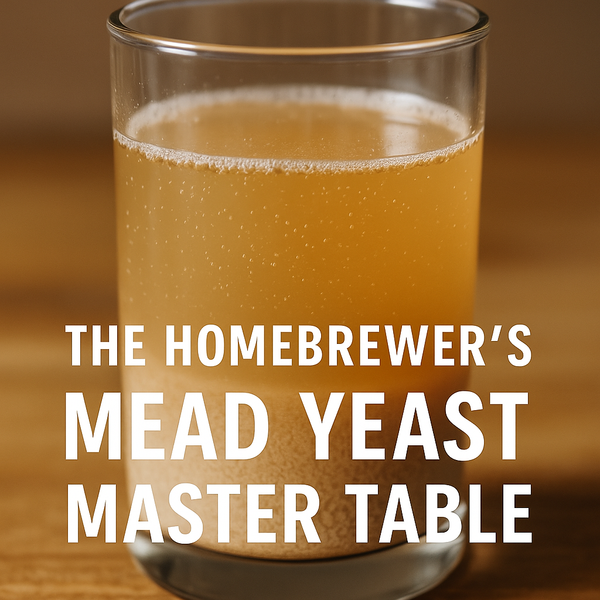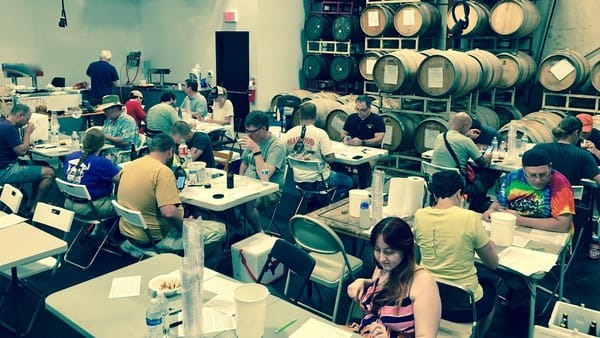Calibration Series: Personalized Sulfate and Chloride in Beer
The sulfate/chloride ratio has led many home brewers down a path of following water profile recommendations without understand the key constituents, and where their preferences fall, or understanding that breweries treat their water (especially by heating). This also has an impact when you read certain things in BJCP targets such as "Burton" versions use medium to high sulfate water – in describing ESB’s, and should not be construed as overly mineralized flavors, yet it is common to see 600+ ppm sulfate levels at times. Rather than focus on historic or recommended profiles, we are going to run an experiment to determine our PERSONAL preferences for sulfate and chloride levels. And, besides some math and measurements, we get to drink beer. We will avoid determining molar weights, and focus on practical application in the brewhouse. Credit for this idea goes to AJ deLange and Martin Brungard at HBT, who continually remind us that these ion levels are arbitrary and should be dealt with based on personal preference!
EDIT: Martin Brungard weighed in suggesting doubling the concentration in the solution below. It makes sense to prevent dilution of the beer being dosed. http://www.homebrewtalk.com/f128/water-adjustment-highly-hopped-beers-457336/ - so will add in additional measures for concentration.
You will need:
- A calibrated gram weight scale, something that can at least go out to hundreds is best, but we can work with tenths.
- Graduated cylinders that can hold 1 or ½ liter solutions
- Pipettes or droppers with measures that can dose out 1 ml drops
- Distilled water. R/O can be substituted if below 30 ppm TDS
- Gypsum and Calcium Chloride
- A beer, preferably one that you have brewed and know the water profile used to brew
Step 1: Creating calibration solutions
For each salt, measure out 1 (or 2) grams. Be as precise as possible. Next, dissolve the gram of salt into 1 liter of distilled water. You should have two separate solutions now, 1 for calcium sulfate and 1 for calcium chloride, label appropriately. These solutions now represent a 1000 ppm (or 2000 ppm) solution of each salt, and as you add 1 ml doses of each into a beer solution, you can calculate the weight of the salt necessary to achieve the flavor profile that you prefer (adding it to the existing water profile). We should note that you are building upon the water ion concentration in the brewed beer, so this is additive.
Using DI water, you will achieve the following hardness settings in the solutions:
Gypsum Solution @ 1000 ppm: Calcium = 232.6 ppm, Sulfate = 558.1 ppm
Gypsum Solution @ 2000 ppm: Calcium = 465.2 ppm, Sulfate = 1116.2 ppm
Calcium Chloride Solution @ 1000 ppm: Calcium = 272.3 ppm, Chloride = 482.6 ppm
Step 2: Tasting
This is best accomplished with a moderately hoppy pale beer like a pale ale (for sulfates) or an amber or brown ale if you wish to feature maltyness. Using a beer brewed with a known water profile can help if you intend to rebrew that specific recipe and tweak the water profile.
Carefully decant the beer into known volumes, such as 500 ml. Knowing the volume is critical to calculating later additions. I would start with 4 glasses of 500 ml. It is helpful to remove some, but not all, of the carbonation as the dissolved salt may create additional nucleation sites. I pour into a measured cylinder, and then into a small style appropriate glass.
Into each goes an increasing concentration of gypsum or calcium chloride solution (not mixed initially), and notes taken. First glass gets 1 ml, second 2 ml and so on. By doing so, you can calculate the weight of the salt additions into each glass. Or choose a log scale and double each addition as 1, 2, 4, and 8 ml additions. Use some common sense, using a 1 ml scale when you know the sulfate level is already very high, or multiples if the sulfate is extremely low. Have an idea of where you want to start and work backward or forward from there.
1 ml of 1000 ppm solution = 1 mg of salt (gypsum for example) in the solution
Taste each glass carefully, rinsing your mouth with water between. We are focused on taste, but smell also affects the taste process, so do this with a fresh palate and no strong aromas around. If you use the log scale additions, you may choose to do a linear batch next with 1 ml doses up and down from your preference until you find the sweet spot.
Determine which dosed beer you prefer, and if you like, determine which beer begins to taste minerally and note the levels to determine your taste threshold. You may need to pour additional batches to achieve much higher concentrations!
You can also repeat and refine this with more careful measurements or mixing both solutions. It may also be a good test with a friend or beer judge – laying out beers across a board, some sulfated and some with chloride and get their preferences as well.
Step 3: Scaling
Based on your notes, and your favorite dosed beer, it is then possible to scale the additions necessary to achieve the proper mineral salt additions. Let’s suppose that you like the third sample with 3 ml of 1000 ppm gypsum solution, and that you brew 5.5 gallon batches. Some simple math:
5.5 gallons = 5.5 x (3.78541) = 20.8198 liters, or 20.8 liters rounded. This is the finished beer amount, and where the ppm is measured for your finished beer.
The preferred 3 ml doses of calcium sulfate solution is equivalent to 3 mg of gypsum by weight. This went into a 500 ml beer solution, so results in 6 mg/liter or 6 ppm.
3 mg into 500 ml = 6 mg into 1 liter. 6 mg/liter x 20.8 liters = 124.8 mg gypsum in your finished beer volume, in addition to any weights added at the time of brewing. So if you previously used 1 gram, then you would now use 1.13 grams.
That 6 ml addition in DI water (not recommended to brew without minerals) would result in a wimpy 3.3 ppm Sulfate and 1.4 ppm Calcium profile. For each 1 ml (1 mg) of solution into a liter volume of distilled water, you are adding roughly (estimated):
1000 ppm Gypsum/ 1 ml: Calcium = 0.2 ppm, Sulfate = 0.6 ppm
1000 ppm Calcium Chloride/ 1 ml: Calcium = 0.3 ppm, Chloride = 0.5 ppm
This may be useful to estimate the starting and ending doses in your test, if you are trying to achieve a different profile from the original.
Note: we are ignoring the water volume contribution of the doses in the math above. It may be important if you are going into larger doses of solution additions to account for volume change. Those volumes must also be understood in the calculation by adding the additional volume and normalizing to 1 liter standard volume. As this exceeds the calibration tolerance of most home scales – you can generally ignore the additional volume, or double the concentration of the testing solutions.
We are also ignoring the purity of the salts in the additions, which can vary significantly. For example, the calcium chloride we can get from our LHBS is known to be about 80% pure... so for commercial use, that purity level must be taken into account in determining ppm levels.
Step 4: Refinement
The rubber really meets the road when you have a very predictable water source (hardness and alkalinity), which is difficult to achieve without pretreatment (R/O, DI, etc.). Being able to reliably brew with the same liquor for the same recipe should take all of the guessing out of the equation. However, it is also important to remember that the above is calibration to YOUR PERSONAL PREFERENCES. Judges and colleagues may have significantly different opinions on what should be in your hoppy IIPA or in your milk stout.
Putting this into practice in the brewhouse may be challenging. We have not considered at all the acidity of the calcium contributions, nor the buffering capacity of the mash. Using a tool like Bru’n Water can help to achieve a personal water profile (and there is room for you to add your own targets) while managing mash pH.
It should be noted that for commercial use, or definitive results, you should exercise a triple blind study procedure with a decent sample size. This will remove placebo and personal bias, but highly complicate the procedure. The results from the above really represent your personal preference and not an absolute – so your opinion may be that 350 ppm sulfate is necessary for an American Pale Ale, while mine maybe half that amount. If I was brewing commercially – then I would use the triple blind study (with my customers as a sample) to determine the proper sulfate and chloride level for a given recipe and watch for sales correlations to the data.
So, to sum up. Our tastes are as varied as our eye colors, tastes in television shows and music. In beer, it is easy to say that we like a specific style of beer, say IPA, but really we like specific examples, and there are enough commercial IPA to demonstrate a LOT of variety in bitterness, hop usage and even base malt recipes to prove that one size doesn't fit all. Learning where YOUR preference is relative to sulfate and chloride usage will open up new avenues in your brewing.




